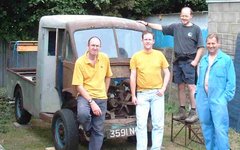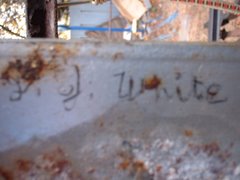

This worked fine in summer but when it got blowy...as it seemed to a hell of a lot, I'd rush out in the middle of a stormy night to battle against the whipping wind in my sails - my tarp getting torn, me getting soaked and frustrated.
So I thought I'd build a carport:

and use fence panels all around it for shelter

But I found I couldn't afford corrugated roof panels when I needed them, so I ended up using the carport framework as a firm structure to experiment with domes; you need sloping surfaces really if you aren't going to end up with water gathering and then falling in on you. Here you can see how I had to use the van itself to brace the roof at one point!


It was all very frustrating and time-consuming and while I was battling the elements, my van wasn't getting done. Eventually John suggested I extend my workshop at the back. You can just see the space on the right (below).

So in the late Summer of 2004 I dug the footings, poured the concrete and started the blockwork. I couldn't afford the proper blocks and so wanted to use the lighter ones that are normally used internally. Before laying them I laid them down flat and painted them with masony paint, which I let soak in and dry (two coats each). I made little progress because that kind of work needs dry weather so that concrete, mortar and paint can go off - and that summer was incredibly wet! Day after day of rain...and all the time the rented concrete mixer stood idle. I did what I could, when I could and didn't get to pour the concrete floor until the following Spring, finishing the roof that Summer. Incidentally, I have had no problem with those blocks. The workshop is water-tight.

I designed a sliding door from reclaimed front doors running on bogeys in channels...but because there was no channel the right depth, I had to make these myself out of T section aluminium extrusion. The door slides to leave an aperture slightly larger than a standard garage door...plenty of space to let the van out, eventually; though it will take some jiggling to get it round the corner and alongside the shed again - to get it though the gardens to the road.

Concurrently, I had de-mounted the cab onto a rolling jig made from heavyweight dexion and some scrap steel and wheels from a shopping trolley....all reclaimed material....and had completely dismantled the van chassis.
Since this photo was taken I have put the lambretta chopper in a lock-up and cleared the decks so that I have a much tidier, more manageable space. In the Summer I can work with the doors open...great for light. And I have insulation (yes, "reclaimed" foamboards) on the doors in winter. A friendly electrician mate has wired it up and put in commando sockets for my spot welder. I have actually made a hell of a lot of progress on the van in very trying conditions....but now that I have this dry workspace, I am going to step things up a gear.
I have to get a move on. The neighbour I am renting the plot next to the shed from wants it back in a year! Without that plot, I am land-locked!
Eeeeeeek!
The following Summer, I went to Iain McKenzie's to learn about shrinking and stretching metal. Click here to read all about it.



















No comments:
Post a Comment